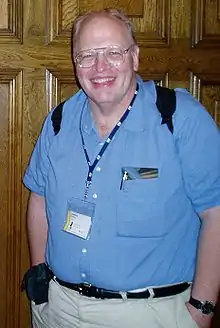Jim Gettys
Jim Gettys (born 15 October 1953) is an American computer programmer. He was involved in multiple computer related projects.
Jim Gettys | |
|---|---|
 Jim Gettys at linux.conf.au, January 2006. | |
| Born | October 15, 1953 |
| Alma mater | Massachusetts Institute of Technology |
| Occupation | Computer programmer |
Activity
Gettys worked at DEC's Cambridge Research Laboratory.
Until January 2009,[1] he was the Vice President of Software at the One Laptop per Child project,[2] working on the software for the OLPC XO-1.[3]
From 2009 through 2014, he worked at Alcatel-Lucent Bell Labs.
Gettys was the co-founder of the group investigating Bufferbloat and the effect it has on the performance of the Internet.,[4] and was a core member of the group from 2010-2017, concluding with his publication of "The Blind Man and the Elephant",[5] calling for the wide adoption of Fair Queuing and AQM techniques across the Internet, particularly RFC8290 .[6]
Since 2017 he has been investigating the potential for reproducible builds and blockchain technology to make possible a more securely updatable and maintainable IoT infrastructure.
He is one of the original developers of the X Window System at MIT and worked on it again with X.Org, where he served on the board of directors.
He served on the GNOME foundation board of directors.
He worked at the World Wide Web Consortium (W3C)[7] and was the editor of the HTTP/1.1 specification in the Internet Engineering Task Force through draft standard.
Gettys helped establish the handhelds.org community, from which the development of Linux on handheld devices can be traced.
One of his main goals at OLPC was to review and overhaul much of standard Linux software, in order to make it run faster and consume less memory and power. In this context, he has pointed out a common fallacy among programmers today: that storing computed values in memory is preferable to recomputing those values later. This, he claims, is often false on current hardware, given fast CPUs and the long time it takes to recover from a potential cache miss.
He holds a BSc degree from MIT in Earth and Planetary Sciences (course 12 — EAPS).[8]
Awards
He won the 1997 Internet Plumber of the Year award on behalf of the group who worked on HTTP/1.1.
Gettys is one of the keepers of the Flame (USENIX's 1999 Lifetime Achievement Award) on behalf of The X Window System Community at Large.
References
- Gettys, Jim (8 January 2009). "So long, and thanks for all the fish". Retrieved 30 August 2017.
- Interview about the One Laptops Per Child project, by LWN.net (June 2006): part I, part II.
- "User:Jg". Retrieved 1 February 2012.
- Gettys, Jim (May–June 2011), Bufferbloat: Dark Buffers in the Internet, IEEE Internet Computing, vol. 15, IEEE, pp. 95–96, doi:10.1109/MIC.2011.56, archived from the original on 2012-10-12, retrieved 2012-02-20
- Gettys, Jim (12 February 2018). "The Blind Man and the Elephant".
- Hoeiland-Joergensen, Toke (January 2018). The Flow Queue CoDel Packet Scheduler and AQM algorithm. IETF. doi:10.17487/RFC8290. RFC 8290.
- Nielsen, Henrik Frystyk; Gettys, Jim; Baird-Smith, Anselm; Prud'hommeaux, Eric Wium; Lie, Håkon; Lilley, Chris (24 June 1997). "Network Performance Effects of HTTP/1.1, CSS1, and PNG". World Wide Web Consortium. Retrieved 14 January 2010.
- "HP Labs inventor profile: Jim Gettys". Archived from the original on August 6, 2007. Retrieved 2005-08-08.
{{cite web}}: CS1 maint: bot: original URL status unknown (link)
External links
- Jim Gettys' home page at Handhelds.org
- jg's ramblings (Gettys' blog where bufferbloat was first exposed)
- bufferbloat.net where work on bufferbloat is taking place
- The X Window System, Version 11 (November, 1990)
- The (Re)Architecture of the X Window System (July, 2004)
- Network Performance Effects of HTTP/1.1, CSS1, and PNG (June 1997)
- Jim Gettys on LinkedIn
